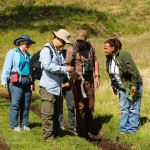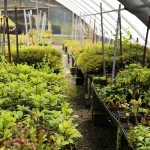Hakalau is a place I love to visit… Stunningly beautiful native forest high on the side of Mauna Kea. A place where the calls of native birds form a chorus in the treetops. The refuge holds an open house once each year, always great to attend. We have done so three times now, taking advantage of a day when volunteers and guides are on hand to teach you about this special place. Normally held in October, the 2013 open house was a victim of the government shutdown. They were forced to cancel the event, but the staff and volunteers made the effort to reschedule and open for Earth Day this year.
Hakalau Forest National Wildlife Refuge encompasses more than 32,000 acres of forest high on the windward side of Mauna Kea. The koa and ʻōhiʻa forest is a refuge for the native birds that are endemic to the island. Staff and volunteers have spent decades slowly restoring the forest in an effort to preserve a little native habitat so that so many species, avian, insect and plant, may have a small place to survive.

We began with a birding hike. Multiple guides were departing the barn area with groups in tow. Heading down a rough track we followed into the rich koa and ʻōhiʻa forest. Bird calls echo from tree to tree, soon we spot many of the birds that are rare elsewhere, but relatively common here. The wild Hawaiian raspberries have had a good winter, I found a few ripe berries to sample, nice flavor if a bit tart.
Iʻiwi, ʻapapane, and a courting pair of ʻelepaio were caught in our binoculars. We did not see the Hawaiian creeper, but we heard them. I really need to drill myself on the calls sometime, birding in Hawaiʻi is an audible exercise as much as visual. Twice we saw ʻio pass overhead, and a nene was to be seen along the road. A good day birding in the forest. One of the guides, a National Park Service ranger, pointed out one of the native lobelias, a plant called Hāhā, by the Hawaiians.

One of the mints was believed extinct until on plant was found on the Hamakua coast. Later, when biologists went to examine this plant again they found it had been killed by wild pigs rooting about. Fortunately cuttings had been successfully propagated at the nursery and the many descendants are doing well. For now the plant is extinct in the wild, but that may change if it can be reintroduced.
A couple of the volunteers related tales of trouble… Gear stolen, fences cut, a general antipathy for the refuge mission from some segments of the community, particularly pig hunters. I have encountered the same mindset myself on occasion… A feeling that one can take and take from the environment and never give back, that the resource is endless. I have met those who believe any restriction, however minor, is an affront to their entitlement to hunt or take whatever they need. Some locals seem to have forgotten the old lessons of resource management that the ancient Hawaiians knew so well. Today is is not that aliʻi who make the rules, it is wildlife managers that set the kapu. At least modern enforcement is not at the sharp end of an ihe.
While there may be some who do not believe in the refuge goals, support from other segments of the community is strong. The volunteer program racks up thousands of hours each year, a dedicated crew that puts in long days of planting native species and removing the harmful invasives. The success of their work can be seen in the lush forest teeming with bird-life. They have created a special place that is a pleasure to visit, eve if they open the doors only once each year.
